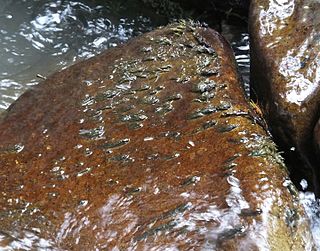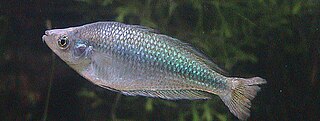
Perch is a common name for fish of the genus Perca, freshwater gamefish belonging to the family Percidae. The perch, of which three species occur in different geographical areas, lend their name to a large order of vertebrates: the Perciformes, from the Greek: πέρκη, simply meaning perch, and the Latin forma meaning shape. Many species of freshwater gamefish more or less resemble perch, but belong to different genera. In fact, the exclusively saltwater-dwelling red drum is often referred to as a red perch, though by definition perch are freshwater fish. Though many fish are referred to as perch as a common name, to be considered a true perch, the fish must be of the family Percidae.

Equisetum fluviatile, the water horsetail or swamp horsetail, is a vascular plant that commonly grows in dense colonies along freshwater shorelines or in shallow water in ponds, swamps, ditches, and other sluggish or still waters with mud bottoms. It is a perennial herbaceous species, growing 30–100 cm tall with erect dark green stems 2–8 mm in diameter, smooth, with about 10–30 fine ridges. At each joint, the stem has a whorl of tiny, black-tipped scale leaves 5–10 mm long. Many, but not all, stems also have whorls of short ascending and spreading branches 1–5 cm long, with the longest branches on the lower middle of the stem. The side branches are slender, dark green, and have 1–8 nodes with a whorl of five scale leaves at each node. The water horsetail has the largest central hollow of the horsetails, with 80% of the stem diameter typically being hollow.

The European perch, also known as the common perch, redfin perch, big-scaled redfin, English perch, Euro perch, Eurasian perch, Eurasian river perch, Hatch, poor man’s rockfish or in Anglophone parts of Europe, simply the perch, is a predatory species of the freshwater perch native to Europe and northern Asia. The species is a popular quarry for anglers, and has been widely introduced beyond its native area, into Australia, New Zealand and South Africa. They have caused substantial damage to native fish populations in Australia and have been proclaimed a noxious species in New South Wales.

Lemanea is a genus of freshwater red algae, in the order Batrachospermales. Both species are considered to be widespread in the northern hemisphere. Although placed in the Rhodophyta it in fact is green in colour.

Theodoxus fluviatilis, common name the river nerite, is a species of small freshwater and brackish water snail with a gill and an operculum, an aquatic gastropod mollusk in the family Neritidae, the nerites.

The freshwater blenny ( is a species of fish in the family Blenniidae. It is found in African rivers and brooks in Algeria and Morocco flowing to the Mediterranean Sea. In Europe it is widespread in the freshwaters of Albania, Croatia, France, Greece, Italy, Montenegro, Spain and Portugal, while in Asia it is in Turkey and Israel. This species reaches a length of 15 centimetres TL. This taxon may be paraphyletic as the populations in Turkey and Israel are more genetically divergent from other populations of freshwater blenny than the Trichonis blenny and it has been suggested that the population in Kinneret Lake in Israel has been proposed as a new species.

Theodoxus is a genus of nerites, small water snails with an operculum, some of which live in freshwater, and some in both freshwater and brackish water, aquatic gastropod mollusks in the family Neritidae, the nerites.

The Australian rainbowfish, known less commonly as the Murray River rainbowfish, is a species of freshwater fish endemic to southeastern Australia. The southernmost species of all rainbowfishes, these fish are very colourful, hence the name; and there is sexual dimorphism with the males being larger and more colourful than females. Australian rainbowfish are schooling fish and will congregate near logs or riverbanks, and are a popular aquarium fish.

Spongilla lacustris is a species of freshwater sponge from the family Spongillidae. It inhabits freshwater rivers and lakes, often growing under logs or rocks. Lacustris is a Latin word meaning "related to or associated with lakes". The species ranges from North America to Europe and Asia. It is the most common freshwater sponge in central Europe. It is the most widespread sponge in Northern Britain, and is one of the most common species of sponges in lakes and canals. Spongilla lacustris have the ability to reproduce both sexually and asexually. They become dormant during winter. The growth form ranges from encrusting, to digitate, to branched, depending upon the quality of the habitat.

Piscicola geometra is a species of leech in the family Piscicolidae. It is an external parasite of marine, brackish and freshwater fishes. It was first described as Hirudo geometra by the Swedish naturalist Carl Linnaeus in his Systema Naturae in 1758.
Ephydatia is a genus of sponges belonging to the family Spongillidae.









